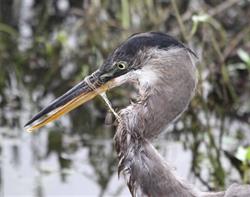Heather Black, IWLA Chesapeake Conservation Corps volunteer
Spring marks the start of outdoor activities for many of us. Here at the Izaak Walton League national headquarters, people have already started taking advantage of the warming weather. Every day there are fishermen standing along the banks of Lake Halcyon, hoping for a bite. Come Earth Day, there will be a new addition to these banks: monofilament recycling stations.
Mono what?
The first time I heard the word “monofilament,” I had no idea what our Clean Water Program Director was talking about. As a child, I was never patient enough to try my hand at fishing, so I have never learned the terminology. I quickly discovered that monofilament refers to a type of fishing line: a single strand of high-density nylon. It is currently the most popular form of fishing line used on reels and manufactured nets across the United States. Why does this matter?
Fishing line can cause major problems for wildlife if it is not disposed of correctly. (Monofilament fishing line in particular is made to last: it takes roughly 600 years to decompose!) Fishing line that is left behind can injure wildlife in two ways: entanglement or ingestion.
 An unsuspecting animal is not going to know what the material is when they come across it. Not only that, the line tends to be extremely thin, making it hard to see. Birds, fish, and terrestrial animals can easily become entangled in fishing line left dangling from trees, floating in the water, or lying on the ground. A tree sprinkled with hooks and fishing line might cause a chuckle – until you see an eagle trapped in fishing lines. Without help, entanglement can lead to injury, drowning, strangulation, or starvation for wildlife. Some animals might think the fishing line is edible. For example, the Florida Fish and Wildlife Conservation Commission found a deceased sea turtle that had ingested over 590 feet of fishing line. Although we do not have sea turtles in Gaithersburg, Maryland, we don’t want the same thing to happen to the wildlife we do have!
An unsuspecting animal is not going to know what the material is when they come across it. Not only that, the line tends to be extremely thin, making it hard to see. Birds, fish, and terrestrial animals can easily become entangled in fishing line left dangling from trees, floating in the water, or lying on the ground. A tree sprinkled with hooks and fishing line might cause a chuckle – until you see an eagle trapped in fishing lines. Without help, entanglement can lead to injury, drowning, strangulation, or starvation for wildlife. Some animals might think the fishing line is edible. For example, the Florida Fish and Wildlife Conservation Commission found a deceased sea turtle that had ingested over 590 feet of fishing line. Although we do not have sea turtles in Gaithersburg, Maryland, we don’t want the same thing to happen to the wildlife we do have!
The League’s property isn’t immune to fishing line litter, whether the material ends up on tree limbs and in the water by accident or neglect. This is where monofilament recycling stations will come in handy. The stations aren’t difficult to build and they provide a place for fisherman to throw away used fishing line, reducing the potential for wildlife to become entangled or ingest the material.
This is a simple DIY project that anyone can build, as shown in this video from the BoatUS Foundation. All you need is two feet of six-inch PVC pipe, a six-inch PVC elbow, a six-inch female threaded adapter, and a six-inch plug.
This is a great project for Scouts and other groups interested in community service. But it’s important to ensure someone is going to properly dispose of the fishing line placed in the bin. Berkley Recycling in Iowa is one location where fishing line can be recycled. Since 1990, Berkley (a fishing equipment retailer) has recycled over 9 million miles of fishing line. To put that in perspective, that is enough fishing line to fill two reels for every angler in the United States. Your local tackle shop might also recycle fishing line.
Ready to get recycling? If you live near Gaithersburg, Maryland, stop by the Izaak Walton League’s headquarters this Saturday, April 21, between 9:00am and 1:00pm to help us install our new monofilament recycling stations! It is simple stewardship projects like this that can have the greatest impact on our environment.